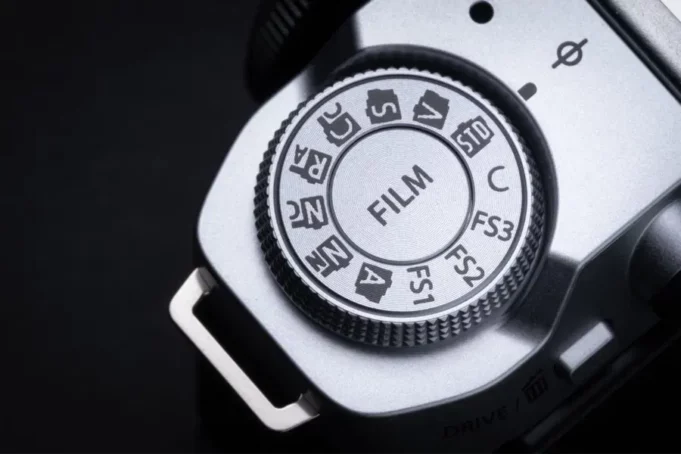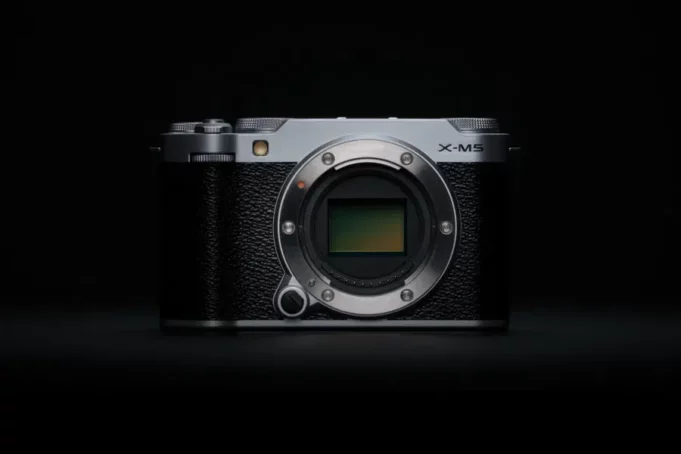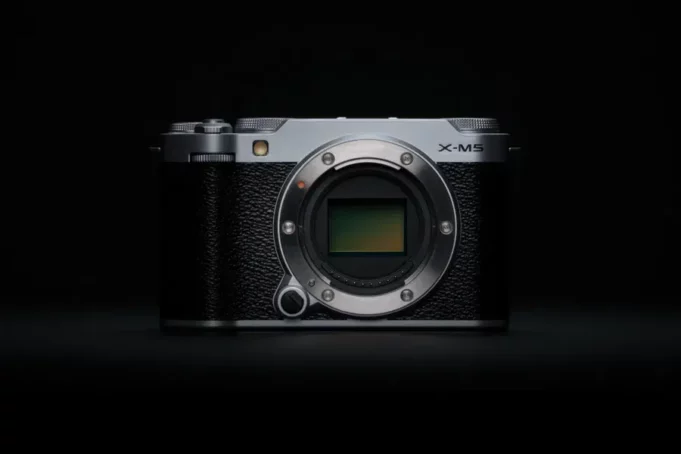While the dedicated ILE camera market may be slowing, the specs sure aren’t.
Case in point: the new Fujifilm X-M5.
For just $799.95 USD you get a whopping bunch of power in a compact camera body that carries all the hallmark Fujifilm design qualities — which is to say, it’s built like a tank, and will likely provide outstanding performance for the money if it’s anything close to the famed Japanese company’s previous models.
Fujifilm X-M5: Key Specs
Here are just some of the notable highlights:
- 26MP APS-C X-Trans Sensor CMOS 4
- 355 grams / 13 ounces (the lightest X-Series camera available today)
- Dedicated film simulation dial with 20 modes (interesting choice, making it suitable for those who want quick looks without a lot of post production coloring work)
- Fully articulating LCD
- 6K 30p 4:2:2 10-bit video (what more could you want for YouTube, content creation, etc.?)
- MSRP: $899 with XC15-45mmF3.5-5.6 OIS PZ Lens Kit
- Available: Amazon
Great Value for Vloggers and Content Creators
Oh, and let’s, again not forget that price of only $800 — as of today one of the most affordable APS-C vlogging cameras on the market. And since the body uses the standard, and well regarded, Fujifilm X-mount you can tap into the vast well of lenses available on that system — including a new 500mm telephoto lens Fujifilm has just released for outdoor and wildlife enthusiasts.

There are some tradeoffs. For this price point you can’t expect everything, though it does deliver a lot.
Limitations to Be Aware Of
For one thing, there’s no IBIS (in-body image stabilization). That means it won’t be so great for those who want steady handheld shots. This can be mitigated somewhat by using a lens with optical stabilization. But other camera bodies with in-body IBIS will provide that much more ability to stabilize shots that some Vloggers and YouTubers will want.
Also, in terms of storage there’s nothing fancy to report. So don’t expect super high-speed CFExpress cards or anything of the sort. Instead, you’ll find a good old fashioned, but completely fine, SD card. On the upside, it does everything you need for capturing up to 4K/60 video and they’re easily available and quite cheap these days. All-in-all I think this one’s not a big deal, especially for the intended use cases, which don’t involve professional film productions for instance.
Fujifilm Raises the Bar for Price/Performance for Content Creation
Regardless of whether this camera is right for you and your projects it’s hard to deny the price-performance value. By my estimation, this is a knockout for the money.
You get 4K/60 10-bit 4:2:2 video, with, if you want, Fujifilm’s beloved film looks available with the twist of a dial. And it can shoot up to 6K should you need the extra resolution for re-framing shots, or working with effects in post.
RELATED IN CAMERAS:
Best Mirrorless Cinema Camera: Sony FX30 vs Panasonic GH6 vs Fujifilm X-H2S
Plus, it gets you into the Fujifilm system for a reasonable price, and opens up a lot of doors for various glass options. Existing Fuji users may be interested in the X-M5 as a B-cam. Its compact size might make for a nice option for crash cams, gimbals and tight quarters.
All said in done, the Fujifilm X-M5 has me slightly incredulous: yes, the smartphone camera continues to improve, but so too apparently does the dedicated YouTube and content creation camera. Fujifilm made sure of that with this new X-series model.
FAQ
Is the Fujifilm X-M5 good for vlogging?
Yes, it offers 6K 30p video, 20 film simulation modes, and a fully articulating screen—making it ideal for YouTubers and vloggers.
Does the Fujifilm X-M5 have in-body stabilization (IBIS)?
No, it relies on lenses with optical stabilization, which might be a drawback for some vloggers.
How does the Fujifilm X-M5 compare to the X-E4 and X-T30 II?
The X-M5 stands out for its lightweight design (355g) and compact body. Compared to the X-T30 II, it offers advanced features like F-Log 2 with 14+ stops of dynamic range and enhanced video capabilities such as 6.2K open gate recording. However, it lacks an electronic viewfinder (EVF) and IBIS, both present in some competing models, such as the X-S20.
What makes the X-M5 good for video and vlogging?
This camera offers impressive video features, including 6K 30p 10-bit recording, 4K 60p with minor cropping, and a Vlog-specific shooting mode for easy auto-focus adjustments and background defocus. Its lightweight frame and articulating screen make it ideal for content creators on the go. It also supports USB connection for quick file transfers via the Fujifilm X App.
Can the X-M5 handle fast action and wildlife photography?
Yes, the X-M5 performs well in burst shooting, offering 8 fps with a mechanical shutter and up to 30 fps with a 1.25x crop using the electronic shutter. The autofocus system leverages AI-based subject tracking, detecting animals, birds, vehicles, and more, which is a boon for wildlife and sports photography.
How is the X-M5 positioned in the X-series line-up and what are some factors to consider when shopping?
The Fujifilm X-M5 sits near the middle of Fujifilm’s X-series lineup, offering a lightweight, compact body aimed primarily at content creators, vloggers, and enthusiasts. Here’s how it compares with other models to help you decide which is right for you:
Entry-Level Options
- Fujifilm X-E4:
A more affordable option with a minimalist design. It offers similar 26MP APS-C performance but lacks an articulating screen and has fewer video-oriented features. Ideal for street photographers looking for a compact, rangefinder-style camera.- Fujifilm X-T30 II:
Positioned slightly below the X-M5. It has similar imaging capabilities but includes an electronic viewfinder (EVF), which the X-M5 lacks. However, it doesn’t offer advanced video features like 6K recording or F-Log2, making the X-M5 more appealing for video creators.Mid-Range Options
- Fujifilm X-S10:
This model is geared towards photographers who want in-body stabilization (IBIS). If IBIS is essential for your work—such as handheld photography or video—it might be a better fit, though it lacks some of the video refinements the X-M5 offers.- Fujifilm X-S20:
A step above the X-M5 with more advanced video functionality, such as higher dynamic range and longer recording times. It also features IBIS, making it better suited for hybrid shooters working across photography and videography.High-End Models
- Fujifilm X-H2 and X-H2S:
These are the flagship models aimed at professionals, offering advanced autofocus, higher resolution (up to 40MP in the X-H2), and support for CFexpress cards. They’re larger and more expensive but ideal for professionals needing top-tier performance and features.X-M5’s Key Appeal
The X-M5 strikes a great balance between portability and performance, particularly excelling in video with 6K 30p recording and vlog-friendly features. While it lacks IBIS and an EVF, it offers excellent video features at a reasonable price point, making it a compelling choice for creators on the go or those looking for a second camera in the Fujifilm system.
If you prioritize video capabilities over stabilization and want a compact, affordable option, the X-M5 is a solid choice. For those needing IBIS or a viewfinder, the X-S10 or X-T30 II may be more appropriate, while professionals may lean towards the X-H2 series for advanced features.
Key Takeaway TL;DR
The Fujifilm X-M5 is an attractive option for vloggers and photographers seeking a capable, compact camera. It delivers a lot for the price, even with a few tradeoffs. Whether you’re a new user entering the Fujifilm ecosystem or a current owner looking for a secondary camera, the X-M5 offers exceptional value.



